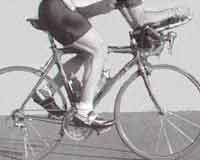Where To Sit
Hip Angle. Your choices here are a more open hip angle (sitting further up), or a more closed hip angle (more bent over). The basic rules associated with your hip angle are these:
- The more open your hip angle, the the faster your leg can move and the faster your cadence will be at the expense of power.
- The more closed your hip angle the slower the speed of leg movement but the greater the power generated with each cycle.
As a result, you should try to close your hip angle, by sliding backward a bit, as you go up hills. This, of course, is difficult because it can restrict breathing. Conversely, when going in a tailwind on down a hill, opening your hip angle, by sliding forward a bit in your seat, is considered to be most effective.
The angle that is considered to be an optimal mix of the two is about 60 degrees between the upper leg and torso (see pic below). At a greater angle, the force drops, and at a smaller angle, the speed decreases.
Knee Angle. Peak power in your cycle is produced when the crank arm is horizontal and forward. This area is also known as the 'power zone'. It is generally accepted that peak power occurs when your knee is at about 110 degrees and directly over the pedal spindle when the pedal is in this 'power zone'. Where you sit relative to the bike in order to achieve this optimal angle will be dictated, however, by the ratio of the size of your upper leg to your lower leg.
To get your ratio, measure from the big bump at your hip to the upper bump on the outside of your knee. That's your femur length. Then measure from the lower bump on the inside of your knee to the big bump on the inside of your ankle. That's your tibia length. Divide you femur length by your tibia length and that'll give you your stinkin' ratio. Most people have a slightly longer upper-leg than lower-leg, but that is certainly not the rule.
If your ratio is less than 1.1, you should be seated more forward on the bike. If your ratio is over 1.1 further back is better for you. If your ratio is over 1.15, your hip angle will be even larger, and as a result, you should toss yourself back even further. The shorter your lower leg, the lower your knee will be and the larger the angle at your hip will be. If you have a shorter lower leg relative to your upper leg, and you move too far forward, you will throw the power phase of your pedal stroke out of wack.
Personal Preference. As with many of Gugly's recommendations, your personal preference plays a large part in where you sit. If you like to pedal in larger gears at a cadence around 80 or lower, then sitting further back should benefit you. If you like to spin a little faster, then sitting further up is for you. Also, many triathletes claim that working the bike in a larger gear, vs. a smaller one, often hurts their run leg. Try running immediately after a long bike done in low gear and compare how you feel and perform to the results of a run done after a bike in a higher gear. Lastly, keep in mind that when using aero bars, triathletes often close the hip angle a bit, which may need to be compensated with a slight slide forward in seat position to keep that hip angle from closing too much.
Try to keep the above considerations in mind and try to practice riding more efficiently. Bad habits die hard, but can be well worth the work--so keep tweaking and keep practicing!
A great way to see this in action is to actually watch really good riders to see how they position themselves. Odds are, they sit differently than mediocre riders. Check out the rider below. Note the hip is close to a 60 degree angle and the knee is around 110 degrees while in its 'power zone'.
